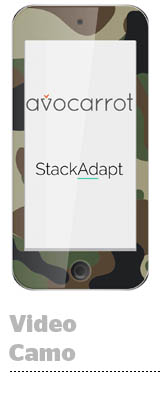 Video ad spend is on the rise. Video supply, on the other hand: not so much.
Video ad spend is on the rise. Video supply, on the other hand: not so much.
“Right now, video is mostly launched either in a pre-roll environment or on a social network, so there’s no scalable way to buy other video formats across the web,” said Vitaly Pecherskiy, COO of native advertising DSP StackAdapt.
For the last several months, StackAdapt has been testing a native video product developed by mobile ad exchange Avocarrot that aims to help advertisers distribute their videos beyond social within in-app environments.
App marketing platform Jampp and native content DSP Zemanta have also been test-driving the product.
Dubbed Wizard and slated for release at next week’s Mobile World Congress in Barcelona, the tool allows publishers to choose from among several templated native ad units – in-feed, carousel, tile-based and the like. They can tailor the ad to fit the look of and feel of the surrounding in-app content.
Avocarrot packages first- and third-party data into the bid request, including whatever data points it can glean directly from the apps with its software development kit integrated – parameters like location, demographics, past user behavior and in-app context.
Advertisers can access the inventory and participate in auctions through their DSPs, just as they would for display, as well as repurpose their TV ads to fit into the content surrounding whatever app they’re buying into.
There are limits to how customized the units can be. For example, the Interactive Advertising Bureau imposes requirements around labeling sponsored content (which may get more prescriptive with the Federal Trade Commission’s recently released enforcement policy on native advertising).
“The main challenge is to ensure that advertisers can reach their consumers in a brand-safe, premium environment with content that’s high-quality and doesn’t distract from the main experience with something intrusive,” said Avocarrot co-founder Conno Christou.
When autoplaying, the videos have no sound by default until the user opts to engage. The tool also allows advertisers to capitalize on their creative by optimizing for completed views. Say a user watches nine seconds of a 15-second in-stream video and then scrolls down and away. The next available ad slot in the feed will pick up where the original video left off and play the remaining six seconds.
Although native in-feed has its benefits over pre-roll, which is by definition interruptive, there’s still a learning curve around adoption, Pecherskiy said.
Because it’s more of an opt-in experience that users can just scroll away from if they’re not interested, native in-feed is often reserved for somewhat longer video content, Pecherskiy said, while pre-roll usually comes in short 15- or 30-second bursts, which means that standard metrics like cost per completed view are very different depending on the format in question.
“Naturally, the cost per completed view for a longer user-initiated video is going to be different from a forced 15-second pre-roll,” Pecherskiy said. “One of the big challenges of working with advertisers is that they oftentimes don’t understand the difference between the two, so native in-feed looks like it’s underperforming – but that’s actually comparing apples to oranges.”
Creative also needs to be a consideration. DSPs can serve contextually relevant native video units to the right target audience, but if the creative is subpar – and the user isn’t forced to watch it as a pre-roll – the views just won’t be there.
“A lot of that is outside the control of the supply or buying partner,” Pecherskiy said. “In that regard, so much is on the shoulders of the agency to produce really great video content.”
Regardless of the kinks that remain to be ironed out, video’s slice of the digital ad spend pie is expected to grow to 14.3% this year, up from 12.8% in 2015, according to eMarketer, with most publishers allured by the higher CPMs that video can bring.
Wizard is a follow-on to Morpheus, a banner-to-native ad converter that Avocarrot released in April. Avocarrot, which is based in Athens and San Francisco, raised a $2 million seed round in May.














